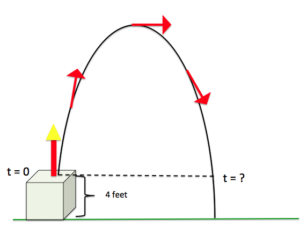Projectiles
Learning Outcomes
- Model projectile motion
 Parabolic water trajectory in a fountain.
Parabolic water trajectory in a fountain.Example
A small toy rocket is launched from a [latex]4[/latex]-foot pedestal. The height (h, in feet) of the rocket t seconds after taking off is given by the function [latex]h(t)=−2t^{2}+7t+4[/latex]. How long will it take the rocket to hit the ground?Answer: The rocket will be on the ground when [latex]h(t)=0[/latex]. We want to know how long, [latex]t[/latex], the rocket is in the air. [latex-display]\begin{array}{l}h(t)=−2t^{2}+7t+4=0\\0=−2t^{2}+7t+4\end{array}[/latex-display] We can factor the polynomial [latex]−2t^{2}+7t+4[/latex] more easily by first factoring out a [latex]-1[/latex] [latex-display]\begin{array}{c}0=-1(2t^{2}-7t-4)\\0=-1\left(2t+1\right)\left(t-4\right)\end{array}[/latex-display] Use the Zero Product Property. There is no need to set the constant factor [latex]-1[/latex] to zero, because [latex]-1[/latex] will never equal zero.
[latex]2t+1=0\,\,\,\,\,\,\text{OR}\,\,\,\,\,\,t-4=0[/latex]
Solve each equation.[latex]t=-\frac{1}{2}\,\,\,\,\,\,\text{OR}\,\,\,\,\,\,t=4[/latex]
Interpret the answer. Since t represents time, it cannot be a negative number; only [latex]t=4[/latex] makes sense in this context. We can check our answer when [latex]t=4[/latex]. [latex-display]\begin{array}{c}h(4)=−2(4)^{2}+7(4)+4=0\\h(4)=-2(16)+28+4=0\\h(4)-32+32=0\\h(4)=0\end{array}[/latex-display] Therefore, the rocket will hit the ground 4 seconds after being launched.Example
Use the formula for the height of the rocket in the previous example to find the time when the rocket is [latex]4[/latex] feet from hitting the ground on its way back down. Refer to the image. [latex-display]h(t)=−2t^{2}+7t+4[/latex-display]
Answer: We are given that the height of the rocket is [latex]4[/latex] feet from the ground on its way back down. We want to know how long it will take for the rocket to get to that point in its path. We are going to solve for t. Substitute [latex]h(t) = 4[/latex] into the formula for height, and try to get zero on one side since we know we can use the zero product principle to solve polynomials. Write and Solve:
[latex]\begin{array}{l}h(t)=4=−2t^{2}+7t+4\\4=-2t^2+7t+4\\\underline{-4}\,\,\,\,\,\,\,\,\,\,\,\,\,\,\,\,\,\,\,\,\,\,\,\,\,\,\,\,\,\underline{-4}\\0=-2t^2+7t\end{array}[/latex]
Now we can factor out a [latex]t[/latex] from each term:
[latex]0=t\left(-2t+7\right)[/latex]
Solve each equation for [latex]t[/latex] using the zero product principle:
[latex]\begin{array}{l}t=0\text{ OR }-2t+7=0\\\,\,\,\,\,\,\,\,\,\,\,\,\,\,\,\,\,\,\,\,\,\,\,\,\,\,\,\,\,\,\,\,\,\,\,\,\,\,\underline{-7}\,\,\,\,\,\,\,\underline{-7}\\\,\,\,\,\,\,\,\,\,\,\,\,\,\,\,\,\,\,\,\,\,\,\,\,\,\,\,\,\,\,\,\,\,\,\,\,\,\,\frac{-2t}{-2}=\frac{-7}{-2}\\\,\,\,\,\,\,\,\,\,\,\,\,\,\,\,\,\,\,\,\,\,\,\,\,\,\,\,\,\,\,\,\,\,\,\,\,\,\,t=\frac{7}{2}=3.5\end{array}[/latex]
It does not make sense for us to choose [latex]t=0[/latex], because we are interested in the amount of time that has passed when the projectile is [latex]4[/latex] feet from hitting the ground on its way back down. We will choose [latex]t=3.5[/latex].
Check the answer on your own for practice.
The rocket will be 4 feet from the ground at [latex]t=3.5\text{ seconds}[/latex].Licenses & Attributions
CC licensed content, Original
- Parabolic motion description and example. Provided by: Lumen Learning License: CC BY: Attribution.
- Factoring Application - Find the Time When a Projectile Hits and Ground. Authored by: James Sousa (Mathispower4u.com) for Lumen Learning. License: CC BY: Attribution.
CC licensed content, Shared previously
- Parabolic water trajectory. Authored by: By GuidoB. Located at: https://commons.wikimedia.org/w/index.php?curid=8015696. License: CC BY-SA: Attribution-ShareAlike.
